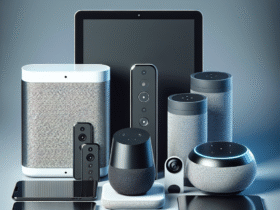Essential Tech Gadgets Every Modern Family Needs: Complete Buying Guide
Technology has become an integral part of family life, enhancing communication, safety, education, and entertainment. However, with countless gadgets available, it can be overwhelming to determine which devices truly add value to your family’s daily routine. This comprehensive guide examines the essential tech gadgets that every modern family should consider, focusing on practical benefits, safety features, and long-term value.
Communication and Connectivity Essentials
1. Family Smartphone Strategy
Priority Level: Critical | Budget Range: $200-$1,200 per device
Smartphones serve as the foundation of modern family communication, but choosing the right devices requires balancing features, safety, and cost across different age groups and needs.
Key Considerations by Age Group:
- Young Children (8-12): Basic smartphones with robust parental controls, GPS tracking, and limited app access
- Teenagers (13-17): Mid-range devices with comprehensive safety features and reasonable data limitations
- Adults: Feature-rich smartphones that support work productivity and family management apps
- Seniors: User-friendly devices with large screens, simple interfaces, and emergency features
Essential Features for Family Phones:
- GPS location sharing for family safety
- Robust parental control capabilities
- Long battery life for all-day reliability
- Durable construction to withstand daily use
- Compatible with family plan carriers
2. Home Wi-Fi and Networking Systems
Priority Level: Critical | Budget Range: $150-$600
Reliable internet connectivity forms the backbone of modern family technology use, supporting everything from remote work and online learning to entertainment and smart home devices.
Mesh Network Benefits:
- Whole-home coverage eliminating dead zones
- Seamless device handoff between access points
- Easy expansion as family needs grow
- Advanced parental controls and device management
- Guest network capabilities for visitors
Family-Focused Router Features:
- Content filtering and website blocking
- Time-based internet access controls
- Device prioritization for work and school
- Usage monitoring and reporting
- Automatic security updates
Safety and Security Technologies
3. Home Security Camera Systems
Priority Level: High | Budget Range: $200-$800
Modern security cameras provide peace of mind for families, offering remote monitoring capabilities, motion detection, and integration with smart home systems.
Essential Security Features:
- High-definition video quality for clear identification
- Night vision capabilities for 24/7 monitoring
- Motion detection with smartphone alerts
- Two-way audio for communication
- Cloud storage with local backup options
Family-Friendly Considerations:
- Privacy controls for different family areas
- Easy setup and maintenance
- Integration with existing smart home devices
- Reasonable ongoing subscription costs
- Reliable customer support and warranties
4. Smart Doorbells and Access Control
Priority Level: High | Budget Range: $100-$400
Smart doorbells enhance family security by providing video monitoring of entrances, package delivery notifications, and remote communication with visitors.
Key Benefits for Families:
- Package theft prevention and delivery monitoring
- Visitor screening when children are home alone
- Integration with home security systems
- Emergency service communication capabilities
- Historical video recording for security reviews
Educational and Learning Technologies
5. Tablets for Learning and Entertainment
Priority Level: High | Budget Range: $150-$500 per device
Tablets serve multiple roles in modern families, supporting educational activities, creative pursuits, and entertainment while offering portability and ease of use.
Educational Applications:
- Interactive learning apps and digital textbooks
- Creative tools for art, music, and video production
- Research capabilities for school projects
- Language learning and skill development programs
- Virtual field trips and educational content
Family Management Features:
- Robust parental controls and content filtering
- Time limits and usage scheduling
- Multiple user profiles for different family members
- Educational app recommendations and curation
- Shared family content and photo libraries
6. Smart Speakers and Digital Assistants
Priority Level: Moderate | Budget Range: $50-$300
Smart speakers provide hands-free convenience for families, supporting everything from music playback and weather updates to homework help and smart home control.
Family-Friendly Uses:
- Voice-activated timers and reminders for daily routines
- Educational questions and homework assistance
- Music streaming and family entertainment
- Smart home device control and automation
- Communication between rooms and family members
Privacy and Safety Considerations:
- Voice recognition for personalized responses
- Parental controls for content and purchasing
- Privacy settings and data management options
- Child-appropriate responses and content filtering
- Emergency calling and safety features
Health and Wellness Technology
7. Fitness Trackers and Smartwatches
Priority Level: Moderate | Budget Range: $100-$400 per device
Wearable technology helps families maintain healthy lifestyles by tracking physical activity, monitoring vital signs, and encouraging active participation in wellness goals.
Family Fitness Benefits:
- Activity tracking and goal setting for all family members
- Health monitoring and wellness insights
- Emergency contact and location features for children
- Family challenges and group fitness goals
- Sleep tracking and routine optimization
Age-Appropriate Features:
- Children: Simple activity tracking, parent communication, GPS location
- Teens: Fitness goals, social features, health education
- Adults: Comprehensive health monitoring, work-life balance tools
- Seniors: Fall detection, medication reminders, emergency features
Entertainment and Family Bonding
8. Streaming Devices and Smart TVs
Priority Level: Moderate | Budget Range: $50-$200 per device
Modern entertainment systems provide families with access to educational content, movies, and shows while offering parental controls and content curation capabilities.
Family Entertainment Features:
- Multiple streaming service integration
- Robust parental controls and content filtering
- Educational programming and documentary access
- Gaming capabilities for family fun
- Voice control and accessibility features
9. Gaming Consoles and Family Gaming
Priority Level: Low to Moderate | Budget Range: $200-$500
Gaming consoles can provide valuable family bonding opportunities while supporting educational games, creative tools, and social interaction.
Family Gaming Benefits:
- Cooperative and competitive family gaming experiences
- Educational games and learning applications
- Creative tools for art, music, and video creation
- Physical activity games promoting fitness
- Social connection with extended family and friends
Smart Home Automation Essentials
10. Smart Thermostats
Priority Level: High | Budget Range: $150-$300
Smart thermostats provide energy savings, convenience, and comfort while allowing families to optimize their home environment automatically.
Family Comfort Benefits:
- Automatic temperature adjustment based on occupancy
- Energy savings through intelligent scheduling
- Remote control when family members are away
- Integration with other smart home devices
- Usage reports and energy efficiency insights
11. Smart Lighting Systems
Priority Level: Moderate | Budget Range: $100-$400
Smart lighting enhances family life through automated schedules, mood setting, and energy efficiency while providing convenience and security benefits.
Family Lifestyle Enhancements:
- Automated lighting schedules for daily routines
- Motion-activated lighting for safety and convenience
- Mood lighting for different activities and times
- Energy efficiency through intelligent control
- Security lighting when family is away
Budgeting and Implementation Strategy
Priority-Based Implementation Plan:
Phase 1 – Critical Infrastructure ($800-$2,000):
- Reliable home internet and networking
- Basic smartphones for family members
- Essential security devices (doorbell or cameras)
Phase 2 – Safety and Education ($500-$1,500):
- Educational tablets for children
- Smart home security expansion
- Basic smart home automation (thermostat)
Phase 3 – Enhancement and Convenience ($400-$1,000):
- Smart speakers and voice assistants
- Fitness tracking devices
- Entertainment system upgrades
Money-Saving Strategies:
- Family Plans: Bundle services and devices for discounts
- Gradual Implementation: Spread purchases over time to manage costs
- Research Sales: Take advantage of seasonal sales and promotions
- Consider Refurbished: Quality used devices for significant savings
- Evaluate Needs: Focus on devices that solve specific family challenges
Setting Up Family Technology Rules
Digital Wellness Guidelines:
- Screen Time Limits: Age-appropriate daily and weekly limits
- Device-Free Zones: Bedrooms, dining areas, and family time
- Educational Priority: Learning and creative uses before entertainment
- Safety First: Privacy settings, stranger danger, and cyberbullying prevention
- Regular Reviews: Monthly family discussions about technology use
Security and Privacy Best Practices:
- Regular password updates and two-factor authentication
- Privacy setting reviews on all family devices
- Safe internet browsing education for all family members
- Regular software and security updates
- Data backup strategies for important family information
Maintenance and Long-Term Considerations
Device Lifecycle Management:
- Regular Updates: Keep software current for security and features
- Performance Monitoring: Replace devices when they no longer meet needs
- Warranty Management: Track warranties and extended service options
- Recycling Plans: Environmentally responsible disposal of old devices
- Upgrade Timing: Strategic replacement based on technology advancement
Future-Proofing Your Family’s Technology
Emerging Technologies to Consider:
- Artificial Intelligence Integration: AI assistants for personalized family experiences
- Enhanced Health Monitoring: More sophisticated wellness tracking
- Improved Security Features: Biometric authentication and advanced threat detection
- Energy Efficiency: Solar integration and smart grid connectivity
- Educational Innovation: Virtual and augmented reality learning tools
Conclusion: Building Your Family’s Tech Ecosystem
Creating an effective family technology ecosystem requires thoughtful planning, gradual implementation, and ongoing management. The key is to focus on devices and services that genuinely enhance your family’s communication, safety, education, and quality of life rather than simply accumulating the latest gadgets.
Start with the foundational elements—reliable internet, appropriate communication devices, and basic security measures. Then gradually expand based on your family’s specific needs, interests, and budget constraints. Remember that technology should serve your family’s goals and values, not dictate them.
Regular evaluation and adjustment of your family’s technology use ensures that these tools continue to provide value as your family grows and changes. By maintaining a balance between embracing helpful innovations and preserving important family traditions and interactions, you can create a technology environment that truly enhances modern family life.
The most successful family technology implementations are those that bring family members together rather than isolating them, prioritize safety and education over pure entertainment, and remain flexible enough to adapt as both technology and family needs evolve.






Leave a Reply